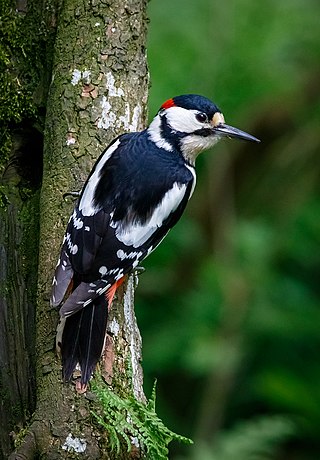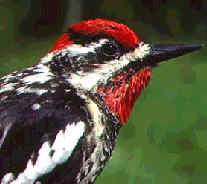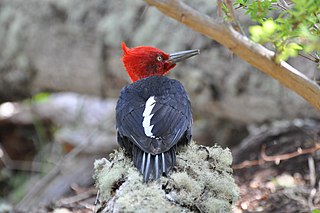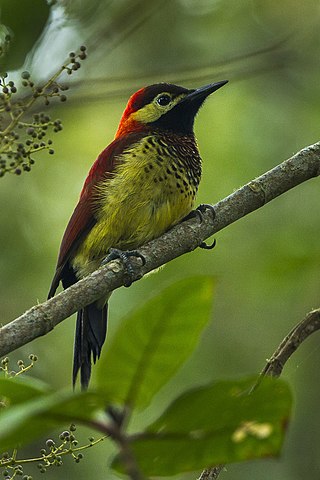
The great spotted woodpecker is a medium-sized woodpecker with pied black and white plumage and a red patch on the lower belly. Males and young birds also have red markings on the neck or head. This species is found across the Palearctic including parts of North Africa. Across most of its range it is resident, but in the north some will migrate if the conifer cone crop fails. Some individuals have a tendency to wander, leading to the recolonisation of Ireland in the first decade of the 21st century and to vagrancy to North America. Great spotted woodpeckers chisel into trees to find food or excavate nest holes, and also drum for contact and territorial advertisement; like other woodpeckers, they have anatomical adaptations to manage the physical stresses from the hammering action. This species is similar to the Syrian woodpecker.

The European green woodpecker, also known as the yaffle and sometimes called a nickle, is a large green woodpecker with a bright red crown and a black moustache. Males have a red centre to the moustache stripe which is absent in females. It is resident across much of Europe and the western Palearctic but in Spain and Portugal it is replaced by the similar Iberian green woodpecker.

The Eurasian nuthatch or wood nuthatch is a small passerine bird found throughout the Palearctic and in Europe. Like other nuthatches, it is a short-tailed bird with a long bill, blue-gray upperparts and a black eye-stripe. It is a vocal bird with a repeated loud dwip call. There are more than 20 subspecies in three main groups; birds in the west of the range have orange-buff underparts and a white throat, those in Russia have whitish underparts, and those in the east have a similar appearance to European birds, but lack the white throat.

Woodpeckers are part of the bird family Picidae, which also includes the piculets, wrynecks and sapsuckers. Members of this family are found worldwide, except for Australia, New Guinea, New Zealand, Madagascar and the extreme polar regions. Most species live in forests or woodland habitats, although a few species are known that live in treeless areas, such as rocky hillsides and deserts, and the Gila woodpecker specialises in exploiting cacti.

The pileated woodpecker is a large, mostly black woodpecker native to North America. An insectivore, it inhabits deciduous forests in eastern North America, the Great Lakes, the boreal forests of Canada, and parts of the Pacific Coast. It is the largest confirmed extant woodpecker species in North America, with the possible exception of the ivory-billed woodpecker, which the U.S. Fish and Wildlife Service has proposed be reclassified as extinct. It is also the third largest extant species of woodpecker in the world, after the great slaty woodpecker and the black woodpecker. "Pileated" refers to the bird's prominent red crest, from the Latin pileatus meaning "capped".

The yellow-bellied sapsucker is a medium-sized woodpecker that breeds in Canada and the northeastern United States.

The red-headed woodpecker is a mid-sized woodpecker found in temperate North America. Its breeding habitat is open country across southern Canada and the east-central United States. It is rated as least concern on the International Union for Conservation of Nature (IUCN)'s Red List of Endangered species, having been down-listed from near threatened in 2018.

The red-bellied woodpecker is a medium-sized woodpecker of the family Picidae. It breeds mainly in the eastern United States, ranging as far south as Florida and as far north as Canada. Though it has a vivid orange-red crown and nape it is not to be confused with the red-headed woodpecker, a separate species of woodpecker in the same genus with an entirely red head and neck that sports a solid black back and white belly. The red-bellied earns its name from the pale reddish tint on its lower underside.

The red-breasted sapsucker is a medium-sized woodpecker of the forests of the west coast of North America.

The red-naped sapsucker is a medium-sized North American woodpecker. Long thought to be a subspecies of the yellow-bellied sapsucker, it is now known to be a distinct species.

Cassin's finch is a bird in the finch family, Fringillidae. This species and the other "American rosefinches" are placed in the genus Haemorhous.

The white-breasted nuthatch is a species of bird in the nuthatch family Sittidae. It is a medium-sized nuthatch, measuring approximately 15.5 cm (6.1 in) in length. Coloration varies somewhat along the species' range, but the upperparts are light blue-gray, with a black crown and nape in males, while females have a dark gray crown. The underparts are whitish, with a reddish tinge on the lower abdomen. Despite not being closely related, the white-breasted nuthatch and the white wagtail are very similar in plumage. The white-breasted nuthatch is a noisy bird. It has a nasal voice and often utters little cries or vocalizations, often composed of repetitions of small invariant whistles. In summer, it is an exclusively insectivorous bird, consuming a wide range of arthropods, but in winter its diet consists mainly of seeds. The nest is located in the cavity of a tree. The clutch consists of five to nine eggs, incubated for two weeks by the female, who is fed by the male. The two adults then feed the young until they fledge, and for a few weeks after that.

The brown creeper, also known as the American treecreeper, is a small songbird, the only North American member of the treecreeper family Certhiidae.

The olive-sided flycatcher is a small to medium sized passerine bird in the family Tyrannidae, the Tyrant flycatcher family. It is a migratory species that travels from South to North America to breed during the summer. It is a very agile flyer and mainly consumes flying insects on flight. Since 2016, this species has been assessed as being near-threatened globally (IUCN) and threatened in Canada (SRA) due to its declining populations.

The flammulated owl is a small migratory North American owl in the family Strigidae. It is the only species placed in the genus Psiloscops.

The crimson-crested woodpecker is a species of bird in subfamily Picinae of the woodpecker family Picidae. It is found in Panama, Trinidad, and in every mainland South American country except Chile and Uruguay.

The hermit warbler is a small perching bird. It is a species of New World warbler or wood-warbler. They are a migratory bird, the breeding range spanning the majority of the west coast of the United States. Their winter range includes parts of Mexico and Central America as well as parts of the southern California coast.

The Magellanic woodpecker is a species of large woodpecker found in southern Chile and southwestern Argentina; it is resident within its range. This species is the southernmost example of the genus Campephilus, which includes the famous ivory-billed woodpecker.

The crimson-mantled woodpecker is a species of bird in subfamily Picinae of the woodpecker family Picidae. It is found in Bolivia, Colombia, Ecuador, Peru, and Venezuela.

The Cuban green woodpecker is a species of woodpecker in the family Picidae and tribe Melanerpini, known locally in Cuban Spanish as carpintero verde. It is the only species within the genus Xiphidiopicus and is one of two woodpeckers endemic to Cuba. It is the most widespread and common woodpecker in Cuba, inhabiting primarily woodlands, as well as dry and wet forests, pine forests and mangroves. The population of the Cuban green woodpecker is stable and its status is listed as "Least Concern".






















